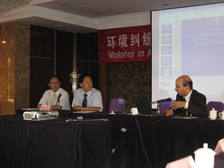International Cooperation on Chinese Environmental Law
Since the launch of the EPA - China Environmental Law Initiative in September, 2007, the EPA has participated in a number of meetings with officials of the China Ministry of Environmental Protection and other experts in order to further the goals of the initiative.
- Clean Water Action Plan Meeting
- Workplan for Cooperation on Environmental Law and Enforcement
- Symposium on Environmental Law and Regulation
- Joint Commission on Environmental Cooperation Meeting
- Launch of EPA - China Environmental Law Initiative
EPA Office of General Counsel Provides Clean Water Act Overview to MEP Officials (November, 2008)

EPA's Office of Water hosted a meeting on November 20, 2008 with Shi Xiaojuan of the China Ministry of Environmental Protection (MEP) Department of Pollution Prevention and other MEP officials to launch the implementation of the Clean Water Action Plan under the US-China Strategic Economic Dialogue. To set the stage for the discussion, EPA's Office of General Counsel presented an overview of the Clean Water Act (PDF, 44 pp, 230k). EPA and MEP discussed China’s program for prevention and control of water pollution, water discharge permitting, and water quality standards.
Article 20 of China’s Water Pollution Control Law (as revised in 2008)  provides for prohibition of water pollution discharges without water pollution discharge permit. A for-comment draft of regulations outlining provisions for application, review, and approval of permits
provides for prohibition of water pollution discharges without water pollution discharge permit. A for-comment draft of regulations outlining provisions for application, review, and approval of permits  as well as inspection and penalties have been made public (available in Chinese only).
as well as inspection and penalties have been made public (available in Chinese only).
EPA and China MEP Launch Workplan for Cooperation on Environmental Law and Enforcement (May, 2008)
On May 20-25, 2008, EPA's Office of General Counsel (OGC), Office of Enforcement and Compliance Assurance (OECA), and EPA Regions III and IX participated in the first meeting of Project Managers under the EPA – China Ministry of Environmental Protection (MEP) MOU Annex 5 on Environmental Law and Enforcement. The main objective of this meeting was to define cooperative work on development, implementation and enforcement of environmental law.
The Annex 5 Work Plan for Sino-U.S. Cooperation in Environmental Law Development, Implementation, and Enforcement (PDF, 15 pp, 7.9 MB) was signed May 20, 2008.
The meeting, coordinated by EPA and MEP Enforcement Offices, included discussion of cooperative work on
- Environmental Law Development
- Enforceable Requirements
- Environmental Impact Assessment
- Regional Environmental Management
- Enforcement System Design
- Emergency Response
- International Enforcement Cooperation
The EPA-MEP team also met with provincial and city environmental officials to learn first-hand how implementation of environmental laws operates at the provincial and city level.
The Environmental Law Project
MEP's Department of Law, Policy, and Regulation has identified as main initial areas of interest in the Environmental Law Project legislative provisions for management of toxic chemicals, and the prevention and control of soil pollution and contaminated sites. During the discussion MEP also expressed interest in cooperative work on provisions for relations between central authorities and provincial authorities. This environmental law project under Annex 5 will provide a mechanism for sharing of EPA experiences under U.S. environmental laws.
Symposium on Environmental Law and Regulation at Tsinghua University Environmental Policy Institute ( April, 2008)
EPA's Office of General Counsel and Tsinghua University Environmental Policy Institute hosted an expert symposium on Environmental Law and Regulation on April 13, 2008. A range of Chinese and U.S. academic, government, and NGO expert speakers discussed the need for further legal reform and bolstering of MEP organization and authority, in particular the need to strengthen relations with and oversight of provincial and local environmental agencies.
Click here for an overview of the symposium (PDF, 3 pp., 21k).
Joint Commission on Environmental Cooperation Meeting (December, 2007)
The Joint Commission on Environmental Cooperation (JCEC) met on December 14, 2007. The Joint Commission is a forum for U.S. Environmental Protection Agency (EPA) and China’s Ministry of Environmental Protection (MEP, formerly SEPA) to discuss cooperation under the EPA-SEPA Memorandum of Understanding on Science and Technical Cooperation in the Field of Environment, signed 12/8/03. (PDF, 10 pp, 382k. Includes Annexes 1-4)
SEPA Minister Zhou Shengxian discussed the new weight given to environmental protection in China's recent 17th Party Congress. EPA and SEPA reviewed progress and plans on cooperation under the existing four annexes to the EPA-SEPA MOU, covering Air, Water, Waste, and Toxics.
Then the meeting turned to discussion of environmental law and enforcement. Lu Xinyuan, Director of SEPA’s Department of Environmental Protection Enforcement and Inspection, indicated that 2008 is a crucial year in China’s law making and law enforcing efforts. EPA Administrator Stephen Johnson emphasized the importance of having good environmental laws and regulations in place and having them enforced. Administrator Johnson and Director Lu then signed the new Annex 5 to the EPA-SEPA MOU on December 14, 2007. This Annex covers Development, Implementation and Enforcement of Environmental Law.
Sulfur Dioxide Emissions Trading Program
China announced plans to develop and implement a nationwide program on sulfur dioxide emissions trading in the power sector. The United States will provide technical assistance to support the development of the necessary infrastructure and institutional capacity for the successful implementation of the program.
The US - China Joint Economic Study (JES) (December, 2007) provided economic analyses of energy saving and pollution abatement policies for the electric power sectors of China and the United States.
The JES noted that installation of flue gas desulfurization equipment and shutdown of small coal-fired boilers are two key policy approaches to reach China's 11th Five-Year Plan energy saving and SO2 emissions targets. The JES indicates that benefits of controlling SO2 emissions would outweigh costs and that a cap and trade approach could achieve lower emissions at less cost than other approaches. The JES noted some important steps forward taken in China, including execution of “Total Sulfur Dioxide Reduction Letter of Responsibility” with provincial and municipal government authorities and six major power companies, issuance by SEPA and the National Reform and Development Commission (NDRC) of a draft Desulfurization Operation and Management Plan for coal-fired generating units that would require construction and operation of FGD equipment at new and expanded coal-fired generating plants, restrictions on sulfur content of coal, requirements to install continuous emission monitors, and an increase in the SO2 Pollution levy amount.
The report identifies that for any air quality program to succeed, effective institutions, infrastructure, and incentives are critical. These include emission measurement protocols to ensure accuracy and consistency, non-compliance penalties high enough to provide an incentive to comply with program rules, and consistent implementation across the country.
Additional information on cooperation between the EPA Office of Air and Radiation and the China Ministry of Environmental Protection is available at the Clean Air and Energy Projects in China web page.
Launch of EPA - China Environmental Law Initiative (September, 2007)
Organizations with which the OGC delegation met in China
- Ministry of Environmental Protection (formerly SEPA) Department of Policy and Law
- MEP Regional Offices for South China, Eastern China
- The National People’s Congress Environmental Protection and Resources Conservation Committee’s Legislative Department
- Environmental Protection Bureaus (EPBs) of Guangdong Province, Guangzhou City, Shanghai, and the Pudong District of Shanghai
- American Chamber of Commerce, Beijing
- American Chamber of Commerce Shanghai
- General Electric
- American Bar Association
- Natural Resources Defense Council
- Center for Legal Assistance to Pollution Victims
- Faculty and students of: Sun Yat-Sen University Law School in Guangzhou, Shanghai Jiao Tong University Law School, Tsinghua University Law School in Beijing, Zhongnan University of Economics and Law / Research Institute of Environmental Law in Wuhan

Former General Counsel Roger R. Martella launched the EPA - China Environmental Law Initiative in September, 2007. Accompanied by EPA Region 8 Regional Counsel Bob Ward and Office of General Counsel International Practice Group attorney Steve Wolfson, the General Counsel traveled to China and met with Chinese environmental officials and Chinese environmental law experts from universities, NGOs, and industry.
The trip came about in the context of increasing Administration cooperation with China through the Strategic Economic Dialogue and increasing EPA cooperation with China in recent years The meetings were organized with a great deal of assistance from the U.S. Embassy and Consulates and the American Bar Association.
Major themes of the meetings included:
Environmental Legislation and Regulation
Chinese experts noted a need to strengthen aspects of China’s environmental laws and the opportunity to learn from the U.S. in a number of areas, including regulation of enterprises, environmental federalism  , and the use of market-based mechanisms.
, and the use of market-based mechanisms.
Discussion focused on several key aspects of China's environmental protection framework, including:
- Plans for reduction in major pollutants
- Target responsibility system for holding local officials accountable for achieving pollution reduction goals
- Plans for new and amended legislation, including the Energy Conservation law, on which a legal drafting team is working as of November, 2007
- Environmental Impact Assessment requirement
- Three Simultaneous policy (which provides for pollution control equipment to be designed, constructed, and operated simultaneously with the design, construction, and operation of new facilities)

Water Pollution Control Law Amendments were adopted in February, 2008.  In addition, future legislation may include provisions on oil and gas pipelines, energy efficiency in construction and recycling, as well as possible amendments to some of the basic environmental laws. Corporate responsibility is being considered as well, as China's Ministry of Environmental Protection (MEP, formerly SEPA) is working with the Chinese banking system to include consideration of environmental compliance in credit decisions.
In addition, future legislation may include provisions on oil and gas pipelines, energy efficiency in construction and recycling, as well as possible amendments to some of the basic environmental laws. Corporate responsibility is being considered as well, as China's Ministry of Environmental Protection (MEP, formerly SEPA) is working with the Chinese banking system to include consideration of environmental compliance in credit decisions.
Reduction of Major Pollutants
The 11th Five Year Plan provides for a 10% reduction in major pollutants by 2010. These reduction targets may vary between the provinces and even within the provinces. Those interested in China’s direction on environmental protection will be closely tracking progress towards these targets.
Regional Offices of China's Ministry of Environmental Protection
China's Ministry of Environmental Protection (MEP, formerly SEPA) is working to enhance its presence throughout China by developing regional offices. These MEP “Regional Supervision Centers”  are said to have authority to supervise the provincial Environmental Protection Bureaus (EPBs) in their jurisdiction but not to instruct them on what to do. Implementation and enforcement responsibility rests primarily with the EPBs. Regional office responsibilities can also include emergency response, addressing inter-provincial pollution problems, and follow-up on complaints. In the near future the central government might give more authority to the MEP, including the regional offices.
are said to have authority to supervise the provincial Environmental Protection Bureaus (EPBs) in their jurisdiction but not to instruct them on what to do. Implementation and enforcement responsibility rests primarily with the EPBs. Regional office responsibilities can also include emergency response, addressing inter-provincial pollution problems, and follow-up on complaints. In the near future the central government might give more authority to the MEP, including the regional offices.

Environmental Conflict Resolution
A number of Chinese environmental officials and experts noted the large number of disputes and complaints they receive, and expressed interest in environmental conflict resolution. Working with the American Bar Association Rule of Law Initiative  , EPA held workshops in Beijing and Wuhan with Chinese environmental officials and other experts on using ADR techniques for environmental conflict resolution.
, EPA held workshops in Beijing and Wuhan with Chinese environmental officials and other experts on using ADR techniques for environmental conflict resolution.
![[logo] US EPA](https://webarchive.library.unt.edu/eot2008/20090508163134im_/http://www.epa.gov/epafiles/images/logo_epaseal.gif)